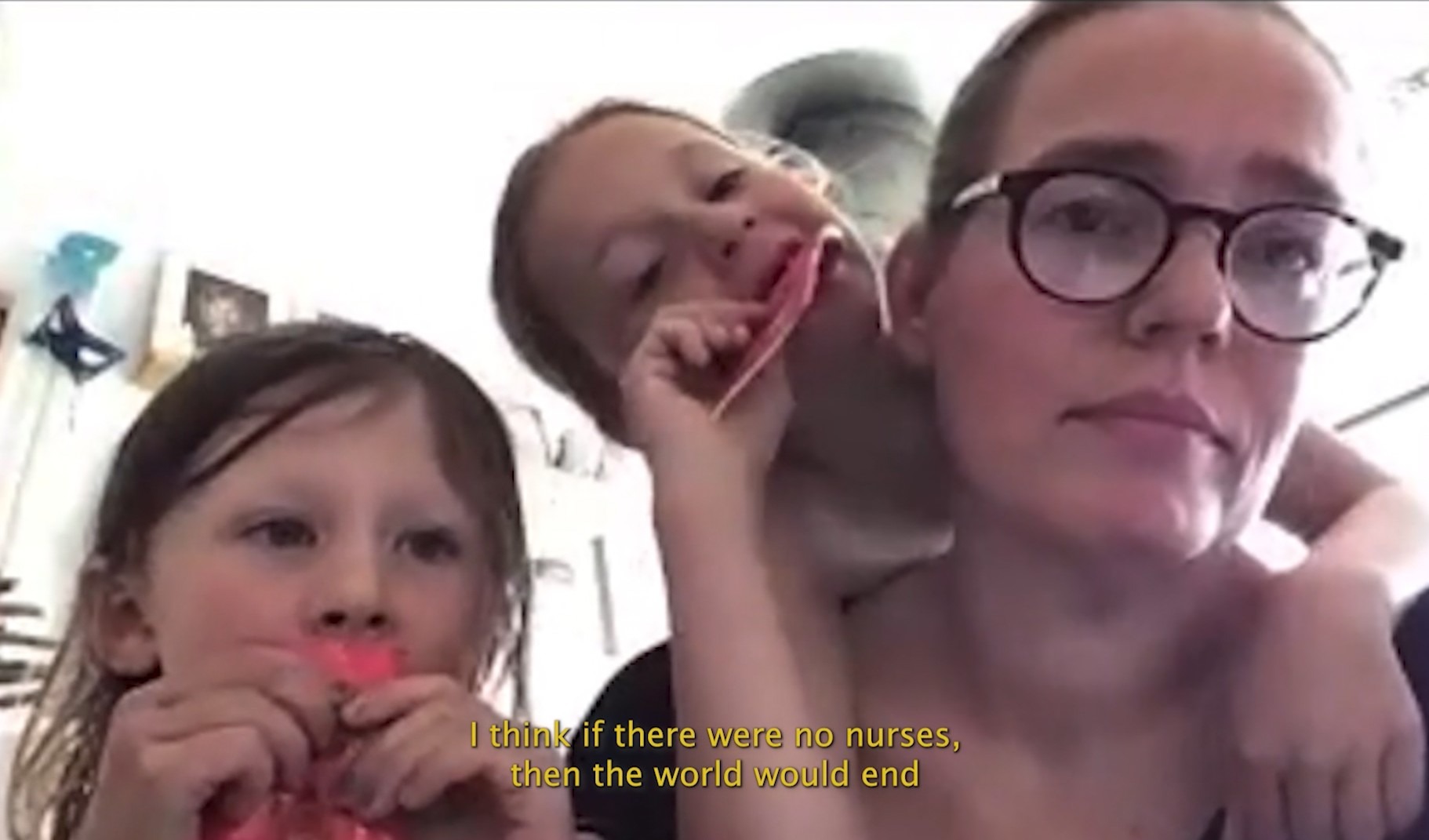In the meantime, midday comes around
10 Nov 2022 - 01 May 2023
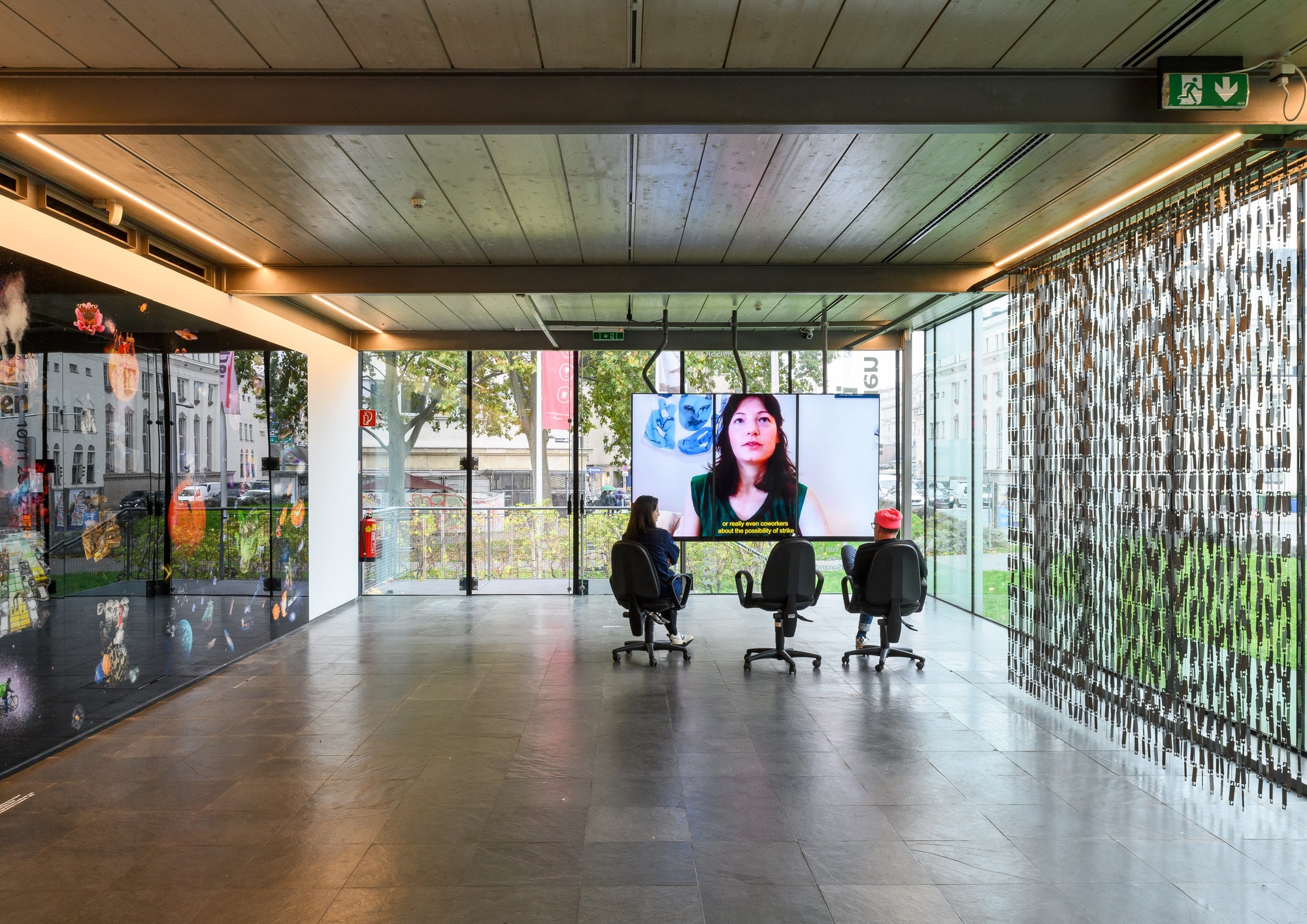
Installation view: In the meantime, midday comes around, Kunsthalle Wien 2022, photo: Iris Ranzinger
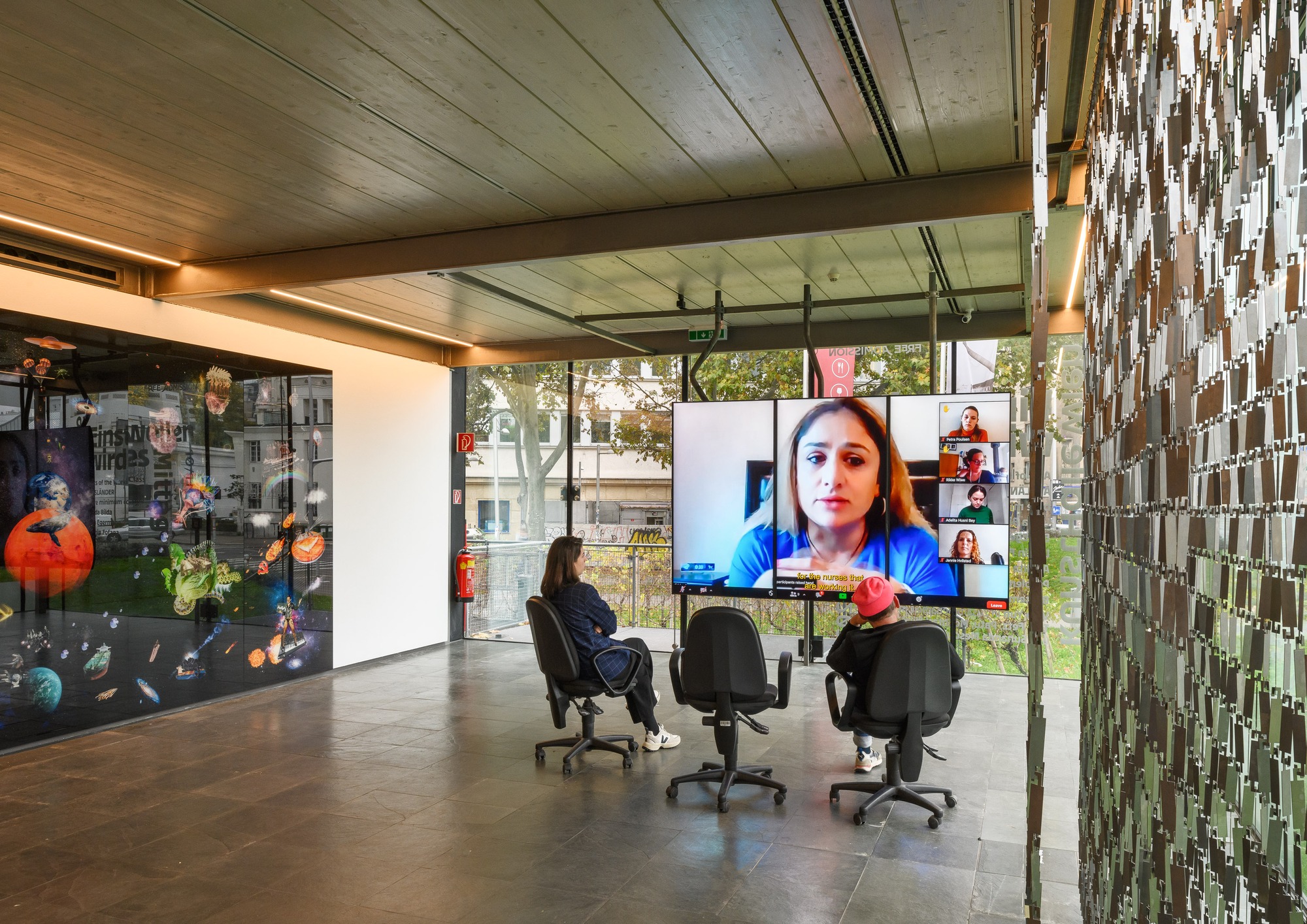
Installation view: In the meantime, midday comes around, Kunsthalle Wien 2022, photo: Iris Ranzinger

Installation view: In the meantime, midday comes around, Kunsthalle Wien 2022, photo: Iris Ranzinger
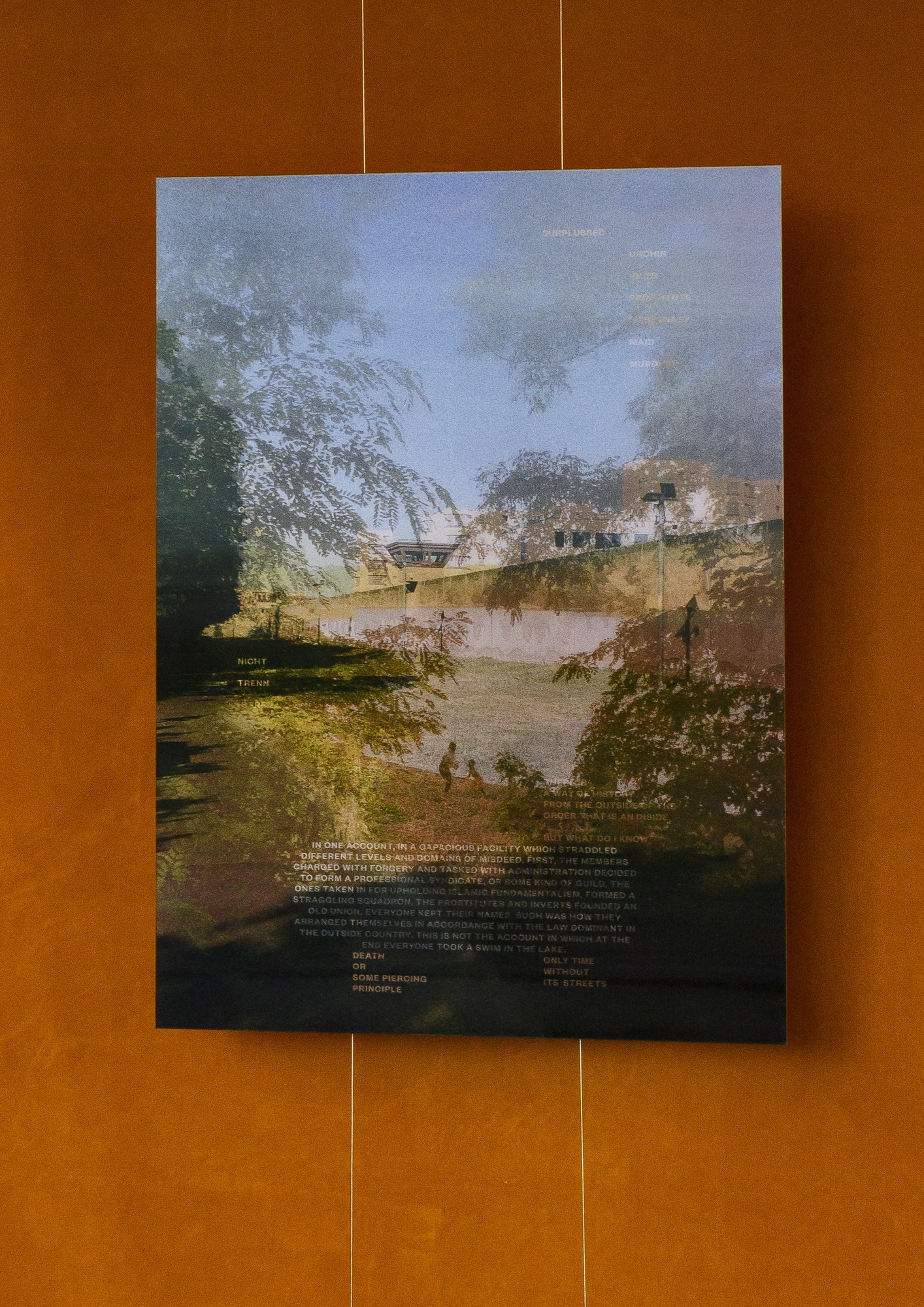
Installation view In the meantime, midday comes around: Bassem Saad, Suppose that Rome is not a human habitation, 2022, Kunsthalle Wien 2022, photo: Iris Ranzinger

Installation view: In the meantime, midday comes around, Kunsthalle Wien 2022, photo: Iris Ranzinger
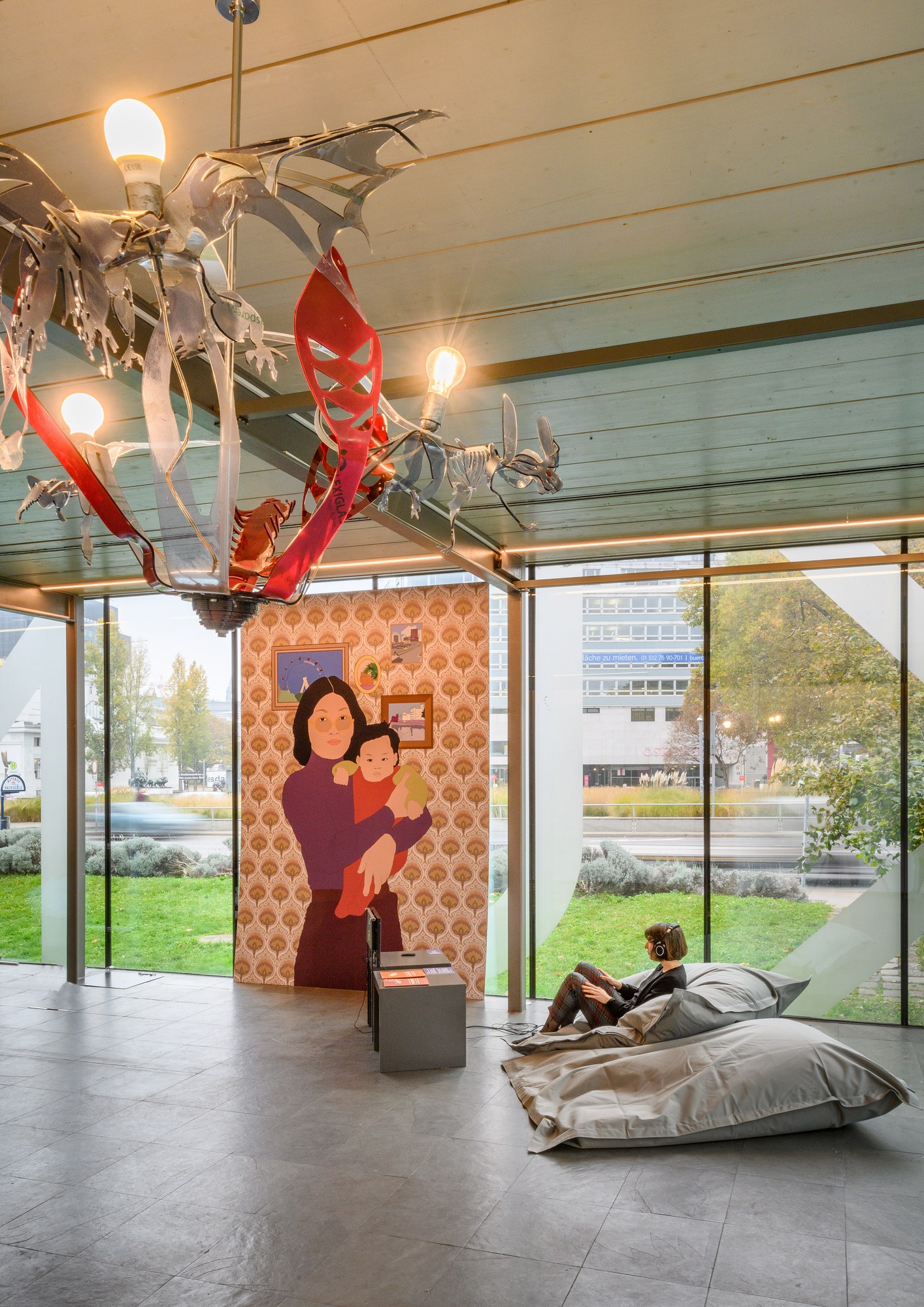
Installation view: In the meantime, midday comes around, Kunsthalle Wien 2022, photo: Iris Ranzinger
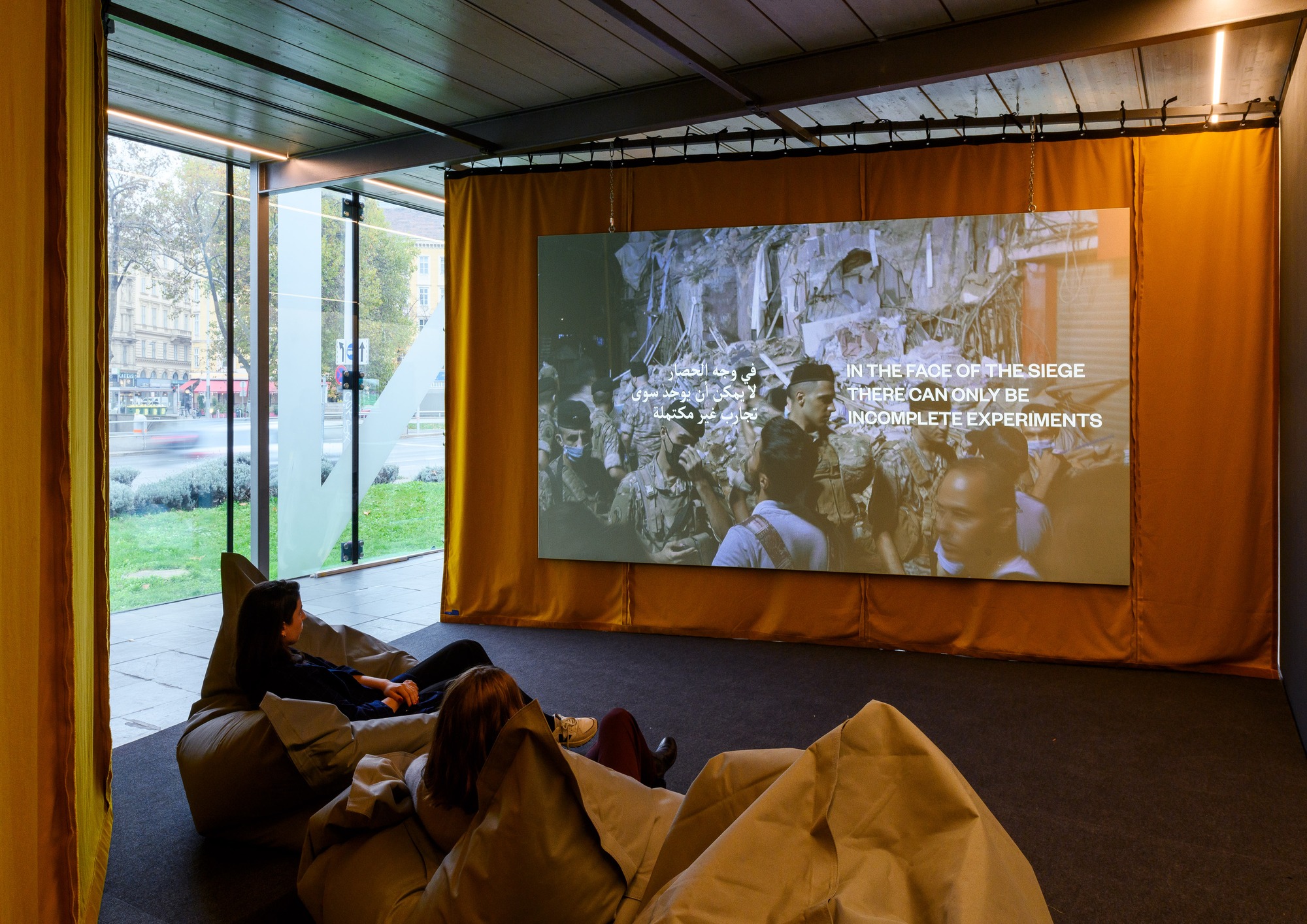
Installation view: In the meantime, midday comes around, Kunsthalle Wien 2022, photo: Iris Ranzinger

Installation view: In the meantime, midday comes around, Kunsthalle Wien 2022, photo: Iris Ranzinger
ARTISTS: Arts of the Working Class • AUSLÄNDER with the invited guests HORIZONT Kollektiv • bare minimum collective • Linda Bilda • Eva Egermann • Lamin Fofana • Adelita Husni-Bey • Problem Collective • Bassem Saad • Vina Yun in collaboration with Tine Fetz, Moshtari Hilal, Sunanda Mesquita, and Patu
CURATORS: What, How & for Whom / WHW (Ivet Ćurlin, Nataša Ilić and Sabina Sabolović)
ASSISTANT CURATOR: Andrea Popelka Exhibition Venue: kunsthalle wien Karlsplatz
“In the meantime, midday comes around” is a quote taken from a seminal sociological study on unemployment from the 1930s called Marienthal: The Sociography of an Unemployed Community that was highly inspirational for this exhibition project. The researchers Marie Jahoda, Paul F. Lazarsfeld, and Hans Zeisel produced the book after several months of study of Marienthal, a district of the community Gramatneusiedl just outside Vienna, which was severely affected by the post-1929 worldwide economic crisis: almost all of its working population became unemployed.
The eponymous phrase is an entry in one of the timesheets filled in by unemployed men as part of the study. It describes the passing of time between rising in the morning and lunchtime: nothing has happened or changed; time is empty and without meaning. The women, on the other hand, remained busy with reproductive labor, as the study also showed.
But if the unemployed man’s sense of time in the 1930s illustrates the loss of a sense of life purpose when existence is not centered around work and its time structures, couldn’t it also illustrate a more contemporary diagnosis: a tedious regime of life fully subordinated to work, the ethics that evolve around it, and the demand for incessant productivity as well as the management and improvement of the self to better comply with these regimes? Isn’t the emptiness similar, albeit full of hustling and productivity, and the collapse of time equally soulcrushing? And how did it come about that we don’t work to live but rather live to work, and that we can scarcely imagine other forms of living?
Taking inspiration from the Marienthal Study, In the meantime, midday comes around revolves around these questions. It looks at the changes to the field of work in the last decades, made more visible by the Covid-19 pandemic, and considers the modalities of collective action and political imagination such global events carry to affect work. One of these long-term changes is what author Aaron Benanav has analyzed as a stagnation and slowdown of economic productivity since the 1970s, which has not (yet) resulted in mass unemployment, but mass underemployment, with people pushed to accept work with miserable conditions and payment.
The artistic positions
The Marienthal Study was published as part of the cultural, political, and scientific program of “Red Vienna”, a socialist experiment that took place in Vienna between the wars, in the 1920s and 1930s, until fascism took over. To this day, it remains a model of cultural experimentation for socialist movements. To honor “Red Vienna” and open up discussions central to the exhibition, in the months preceding the show kunsthalle wien collaborated with Arts of the Working Class (AWC), a Berlin-based collective that produces newspapers sold by houseless people, who receive the profits. AWC produced flags featuring song lyrics that relate to working life in six Viennese municipal housing complexes. The lyrics were chosen through an open call among the inhabitants of the Gemeindebauten, with six winners renumerated for their efforts. The winning lyrics became the basis for flags designed by artists and designers Nour Shantout & Sonia Garziz, Thomas Spallek, and Pauł Sochacki. The flags were installed from September 10 to October 26, 2022—which is Austrian National Day—when they were replaced by the Austrian national flag. In the exhibition, the lyrics are displayed on LED lights circling kunsthalle wien Karlsplatz. The texts recall the struggles and sentiments of working people.
Problem Collective, a research and art collective from Minsk based in Vienna and elsewhere, deals with different historical representations of strikes in Belarus. They approach different eras of strikes (1930s, early 1990s, and post-2020) in a way that is both abstract, as such acknowledging the difficulties of representing the strikes, and very concrete, by using historical documents that remain opaque. This opacity is not only about the suppression of histories of strikes and their lacking documentation; it is also a way to glimpse the uncomfortable limit of striking as a collective action.
Bassem Saad’s video Congress of Idling Persons (2021) connects the social collapse in the aftermath of the Port of Beirut explosion in 2019 with the grassroots organizing of Black Lives Matter in the United States. The “idling” of the title describes modalities of lives and collective struggle available to those “idling”: those fallen out of the system, the surplus, the generally dispossessed, those without 3 reserves, the racialized and incarcerated, the heterogenous masses of those who work but are not necessarily workers. But “idling” also describes the possession of time as a condition of freedom and political subjectification—the sort of freedom necessary for political imagination and action in the world.
Vina Yun looks into the untold history of so-called Gastarbeiter*innen who moved to Austria from Asia in her project HOMESTORIES: Ein Comic über die koreanische Diaspora in Wien [A Comic about the Korean Diaspora in Vienna] (2017), made in collaboration with Tine Fetz, Patu, Moshtari Hilal, and Sunanda Mesquita. The comic is auto-fictional based on the stories of the artist’s mother, who came to Austria from South Korea in 1972 as a nurse, as well as of other women who similarly arrived as nurses or assistant nurses. These stories contribute to articulating guest workers’ experiences of ideological hybridization—or contradictions and similarities as well as differences and continuities between lifestyles and political systems—and reveal the prospective character of guest workers’ migration in relation to future processes of globalization.
The Vienna-based artist and musician collective Ausländer takes its name from an often pejorative German expression for “foreigners”, designating immigrants as “other” to the national body. For the exhibition, Ausländer has developed a performance and installation titled From a Distinguished Foreigner to an Undesirable Alien (2022). It takes the Marienthal Study as its starting point to investigate parallels and differences between the great economic crisis of the 1930s and the permanent and multiple crises of the present moment, relating the “othering” that immigrants are subjected to with environmental collapse and the political imagination and will necessary to overcome it.
The question of collective labor organization is often addressed in the form of labor unions—historically the strongest collective weapon against capitalist exploitation. New York–based artist Lamin Fofana has dedicated an episode of his monthly radio show on NTS Radio, based in Hackney, London, to the new independent Amazon Labor Union in Staten Island, New York, which successfully formed in the spring of 2022. The audio permeates the whole exhibition space, creating a sonic background against which all the works are to be seen.
Adelita Husni-Bey’s video installation On Necessary Work (2022) points to a moment of contemporary labor organization, too. The artist worked on this film together with nurses from the United States and Denmark during the Covid-19 pandemic: a moment of great social collapse that saw an emphasis on “essential” laborers, such as those in the care and health sectors and in the production and distribution of groceries. Many hospital and care-home staff were endangered, fell ill, and died. On Necessary Work also shows the possibility of collaboration and exchange of strategy between nurses, and workers in general, around the world. Additionally, it indirectly poses the question of what the distribution of necessary labor to reproduce society in a post-capitalist world could look like.
The Covid-19 pandemic brought about big shifts in relation to the idea of work and employment being something that gives one a sense of identity, dignity, and a time structure. bare minimum is the name of a British queer-feminist collective and their manifesto (displayed in the exhibition in video form), embraces the refusal of work, idleness, and opting out of grind culture. As the voice-over in the manifesto video puts it: “We want the abolition of everything but care, mutual aid, and community”
Moreover, In the meantime, midday comes around also takes a look at the specific conditions of artistic work and praxis: The late Viennese artist Linda Bilda (she passed away in 2019), a self-declared anarchist, Situationist, and inventor, developed a unique artistic practice that challenged the ways in which artistic work is supposed to operate. She partook in art’s system, but from the sidelines, controlling the circulation and distribution of her comics and other works with keen awareness of artistic autonomy as a living praxis. The exhibition includes a series of her early drawings and prints for the unfinished comic book project The Golden World, which reflects on the economic imperative and subjectivities under neoliberal regimes.
Her practice is the subject of another work included in the exhibition, by the artist, curator, and publisher of Crip Magazine Eva Egermann. The former was a friend of and important influence for the latter, not necessarily in terms of artistic language but rather as a role model for autonomous engaged, feminist artistic praxis. During the exhibition, Eva Egermann will write a text and produce a podcast about her unique perspective on Linda Bilda’s practice and her relentless political and aesthetic subjectivity. The podcast will then be added to the exhibition.
When In the meantime, midday comes around touches on the world of work, it is from the perspective that our time shouldn’t be structured by work and related ideas of progress and growth. Rather, it should follow the flows of other rhythms and activities that are neither useful nor useless, and that we need to imagine, invent, and fight for collectively—a concern that will also be reflected in the extensive public program accompanying the exhibition.
Detailed information on the works within the exhibition, a complete list of works as well as an introduction by the curators WHW can be found in the comprehensive exhibition guide.
CURATORS: What, How & for Whom / WHW (Ivet Ćurlin, Nataša Ilić and Sabina Sabolović)
ASSISTANT CURATOR: Andrea Popelka Exhibition Venue: kunsthalle wien Karlsplatz
“In the meantime, midday comes around” is a quote taken from a seminal sociological study on unemployment from the 1930s called Marienthal: The Sociography of an Unemployed Community that was highly inspirational for this exhibition project. The researchers Marie Jahoda, Paul F. Lazarsfeld, and Hans Zeisel produced the book after several months of study of Marienthal, a district of the community Gramatneusiedl just outside Vienna, which was severely affected by the post-1929 worldwide economic crisis: almost all of its working population became unemployed.
The eponymous phrase is an entry in one of the timesheets filled in by unemployed men as part of the study. It describes the passing of time between rising in the morning and lunchtime: nothing has happened or changed; time is empty and without meaning. The women, on the other hand, remained busy with reproductive labor, as the study also showed.
But if the unemployed man’s sense of time in the 1930s illustrates the loss of a sense of life purpose when existence is not centered around work and its time structures, couldn’t it also illustrate a more contemporary diagnosis: a tedious regime of life fully subordinated to work, the ethics that evolve around it, and the demand for incessant productivity as well as the management and improvement of the self to better comply with these regimes? Isn’t the emptiness similar, albeit full of hustling and productivity, and the collapse of time equally soulcrushing? And how did it come about that we don’t work to live but rather live to work, and that we can scarcely imagine other forms of living?
Taking inspiration from the Marienthal Study, In the meantime, midday comes around revolves around these questions. It looks at the changes to the field of work in the last decades, made more visible by the Covid-19 pandemic, and considers the modalities of collective action and political imagination such global events carry to affect work. One of these long-term changes is what author Aaron Benanav has analyzed as a stagnation and slowdown of economic productivity since the 1970s, which has not (yet) resulted in mass unemployment, but mass underemployment, with people pushed to accept work with miserable conditions and payment.
The artistic positions
The Marienthal Study was published as part of the cultural, political, and scientific program of “Red Vienna”, a socialist experiment that took place in Vienna between the wars, in the 1920s and 1930s, until fascism took over. To this day, it remains a model of cultural experimentation for socialist movements. To honor “Red Vienna” and open up discussions central to the exhibition, in the months preceding the show kunsthalle wien collaborated with Arts of the Working Class (AWC), a Berlin-based collective that produces newspapers sold by houseless people, who receive the profits. AWC produced flags featuring song lyrics that relate to working life in six Viennese municipal housing complexes. The lyrics were chosen through an open call among the inhabitants of the Gemeindebauten, with six winners renumerated for their efforts. The winning lyrics became the basis for flags designed by artists and designers Nour Shantout & Sonia Garziz, Thomas Spallek, and Pauł Sochacki. The flags were installed from September 10 to October 26, 2022—which is Austrian National Day—when they were replaced by the Austrian national flag. In the exhibition, the lyrics are displayed on LED lights circling kunsthalle wien Karlsplatz. The texts recall the struggles and sentiments of working people.
Problem Collective, a research and art collective from Minsk based in Vienna and elsewhere, deals with different historical representations of strikes in Belarus. They approach different eras of strikes (1930s, early 1990s, and post-2020) in a way that is both abstract, as such acknowledging the difficulties of representing the strikes, and very concrete, by using historical documents that remain opaque. This opacity is not only about the suppression of histories of strikes and their lacking documentation; it is also a way to glimpse the uncomfortable limit of striking as a collective action.
Bassem Saad’s video Congress of Idling Persons (2021) connects the social collapse in the aftermath of the Port of Beirut explosion in 2019 with the grassroots organizing of Black Lives Matter in the United States. The “idling” of the title describes modalities of lives and collective struggle available to those “idling”: those fallen out of the system, the surplus, the generally dispossessed, those without 3 reserves, the racialized and incarcerated, the heterogenous masses of those who work but are not necessarily workers. But “idling” also describes the possession of time as a condition of freedom and political subjectification—the sort of freedom necessary for political imagination and action in the world.
Vina Yun looks into the untold history of so-called Gastarbeiter*innen who moved to Austria from Asia in her project HOMESTORIES: Ein Comic über die koreanische Diaspora in Wien [A Comic about the Korean Diaspora in Vienna] (2017), made in collaboration with Tine Fetz, Patu, Moshtari Hilal, and Sunanda Mesquita. The comic is auto-fictional based on the stories of the artist’s mother, who came to Austria from South Korea in 1972 as a nurse, as well as of other women who similarly arrived as nurses or assistant nurses. These stories contribute to articulating guest workers’ experiences of ideological hybridization—or contradictions and similarities as well as differences and continuities between lifestyles and political systems—and reveal the prospective character of guest workers’ migration in relation to future processes of globalization.
The Vienna-based artist and musician collective Ausländer takes its name from an often pejorative German expression for “foreigners”, designating immigrants as “other” to the national body. For the exhibition, Ausländer has developed a performance and installation titled From a Distinguished Foreigner to an Undesirable Alien (2022). It takes the Marienthal Study as its starting point to investigate parallels and differences between the great economic crisis of the 1930s and the permanent and multiple crises of the present moment, relating the “othering” that immigrants are subjected to with environmental collapse and the political imagination and will necessary to overcome it.
The question of collective labor organization is often addressed in the form of labor unions—historically the strongest collective weapon against capitalist exploitation. New York–based artist Lamin Fofana has dedicated an episode of his monthly radio show on NTS Radio, based in Hackney, London, to the new independent Amazon Labor Union in Staten Island, New York, which successfully formed in the spring of 2022. The audio permeates the whole exhibition space, creating a sonic background against which all the works are to be seen.
Adelita Husni-Bey’s video installation On Necessary Work (2022) points to a moment of contemporary labor organization, too. The artist worked on this film together with nurses from the United States and Denmark during the Covid-19 pandemic: a moment of great social collapse that saw an emphasis on “essential” laborers, such as those in the care and health sectors and in the production and distribution of groceries. Many hospital and care-home staff were endangered, fell ill, and died. On Necessary Work also shows the possibility of collaboration and exchange of strategy between nurses, and workers in general, around the world. Additionally, it indirectly poses the question of what the distribution of necessary labor to reproduce society in a post-capitalist world could look like.
The Covid-19 pandemic brought about big shifts in relation to the idea of work and employment being something that gives one a sense of identity, dignity, and a time structure. bare minimum is the name of a British queer-feminist collective and their manifesto (displayed in the exhibition in video form), embraces the refusal of work, idleness, and opting out of grind culture. As the voice-over in the manifesto video puts it: “We want the abolition of everything but care, mutual aid, and community”
Moreover, In the meantime, midday comes around also takes a look at the specific conditions of artistic work and praxis: The late Viennese artist Linda Bilda (she passed away in 2019), a self-declared anarchist, Situationist, and inventor, developed a unique artistic practice that challenged the ways in which artistic work is supposed to operate. She partook in art’s system, but from the sidelines, controlling the circulation and distribution of her comics and other works with keen awareness of artistic autonomy as a living praxis. The exhibition includes a series of her early drawings and prints for the unfinished comic book project The Golden World, which reflects on the economic imperative and subjectivities under neoliberal regimes.
Her practice is the subject of another work included in the exhibition, by the artist, curator, and publisher of Crip Magazine Eva Egermann. The former was a friend of and important influence for the latter, not necessarily in terms of artistic language but rather as a role model for autonomous engaged, feminist artistic praxis. During the exhibition, Eva Egermann will write a text and produce a podcast about her unique perspective on Linda Bilda’s practice and her relentless political and aesthetic subjectivity. The podcast will then be added to the exhibition.
When In the meantime, midday comes around touches on the world of work, it is from the perspective that our time shouldn’t be structured by work and related ideas of progress and growth. Rather, it should follow the flows of other rhythms and activities that are neither useful nor useless, and that we need to imagine, invent, and fight for collectively—a concern that will also be reflected in the extensive public program accompanying the exhibition.
Detailed information on the works within the exhibition, a complete list of works as well as an introduction by the curators WHW can be found in the comprehensive exhibition guide.


